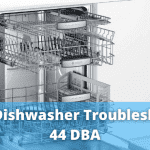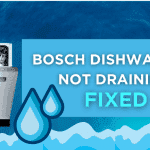Table of Contents
When it comes to connecting up the drain for a dishwasher, most of the time, it’s pretty straightforward, but it’s vital to understand all of your choices, including or without garbage disposal.
If you’re replacing a dishwasher with a new one, it’s usually easiest to duplicate the same drain hookups used on the old model. However, if you’re installing your first dishwasher, you’ll need to install a unique drain fitting known as a Y-branch tailpiece to allow dirty water to flow into your drain system.
You may come across several drain types, including:
- The drain line is connected to the garbage disposal via an air gap.
- A drain line that runs directly to the drain is connected via an air gap.
- The drain line is installed in a “high loop” with the garbage disposal.
- Install a drain line that connects to the sink in a “high loop.”
An air gap fitting, a safety device installed on your sink or countertop through which the dishwasher hose travels, serves as a pressure break in the drain line that prevents dirty drainage water from being back siphoned into a clean washing machine. This device isn’t used by all dishwashers; instead, the “high loop” method, in which the drain line loops up under the sink base cabinet to a point above the dishwasher’s water level to prevent any backflow, is an option.
You’ll need different things depending on the arrangement and whether or not there is an air gap. Before you start, be sure to turn off the water under the sink and unplug your garbage disposal (if you have one).
Things You Will Need To Proceed:
- Screwdrivers
- Utility knife
- 7/8-inch (inside diameter) drain hose
- Hose clamps
- Y-branch drain tailpiece (if needed)
- Garbage disposal drain adapter (if required)
- Pipe clamp or pipe strapping (if needed)
1. Drain Line is Connected to the Garbage Disposal via an Air Gap
If an air gap fitting is utilized, it will be necessary to connect two drain hoses: the factory drain hose from the dishwasher to the smaller of the two tailpieces on the air gap, and a 7/8-inch (inside diameter) hose that runs from the other tailpiece on the air gap to the garbage disposal.
- Connecting Hose to Air Gap: Cut the dishwasher drain hose from the dishwasher as close to the smaller tailpiece on the air gap fitting mounted on the countertop or sink deck as possible with a utility knife. Connect this hose end to the air gap with a hose clamp.
- Connecting Hose to Garbage Disposal: The air gap’s large end is connected to the garbage disposal with a 7/8-inch rubber hose. Connect both hose ends using hose clamps (one on the air gap and one on the garbage disposal inlet nipple).
Warning
[wps_note size=”17″ background=”#fae588″ color=”#333333″ radius=”3″]If the 7/8-inch hose has kinks in it, the drain water will be restricted and, over time, may clog up. If this is the case, you’ll need to shorten it down to size.[/wps_note]
2. Drain Line That Runs Directly to the Drain is Connected Via an Air Gap
The drain hose is coupled to the sink drain through the air gap when connecting a dishwasher drain with an air gap but no garbage disposal.
- Connecting Hose to Air Gap: Begin by connecting the dishwasher drain hose to the small end of the air gap installed on a countertop or sink deck. It may be tough to push the hose onto the air gap fitting.
- Connecting Hose to Drain Pipe: After that, connect the larger side of the air gap to the Y-branch tailpiece on the sink drain with a 7/8-inch rubber hose. If your gutter doesn’t already have this tailpiece, you’ll need to install one. Two sizes of Y-branch tailpieces are available; make sure you get the right one for the 7/8-inch tube leading from the air gap.
- Hose Clamps: Connect both tails of the hose using hose clamps. Before clamping the hose in place, make sure there are no kinks in the tubing. Hoses that are too long may be shortened.
3. Drain Line is Installed in a “High Loop” with the Garbage Disposal
Ensure the local building codes allow for the high loop method rather than an air gap before installing this dishwasher drain connection. In certain areas, the high-loop approach may not be permitted.
- Preparing Drain Hose: From the back of the dishwasher, remove as much of the drain hose as feasible. You’ll need this extra drain hose to create the high loop before connecting the dishwasher hose to the garbage disposal.
- Loop the Drain Hose: Take the dishwasher drain hose and wrap it as high up as feasible under the sink. This tall loop will keep sewage from flowing back into the dishwasher via the garbage disposal. Use a big pipe clamp or flexible pipe strap to secure the hose to the underside of a countertop or a wall near it.
- Connecting Hose: Using hose clamps, attach the garbage disposal’s drain tube to the dishwasher drain tube. A dishwasher connector fitting may be required to join the hose to the garbage disposal. The smaller drain hose end of the connector is connected to the smaller drain hose, while the larger 7/8-inch fitting connects to the garbage disposal.
4. Install a Drain Line that Connects to the Sink in a “High Loop.”
Finally, check your local building codes to ensure that the high loop method is permissible.
- Drain Hose Looping: Pull as much of the drain line away from the dishwasher as possible and loop it as high up under the sink as feasible, then secure it in place. This will prevent wastewater from draining back into the dishwasher’s drain.
- Attaching Hose to Sink Drain: Attach the end of the dishwasher drain line to the Y-branch tailpiece on your drain with a hose clamp, then secure it with a y-branch tailpiece. You may purchase Y-branch tailpieces that are identical in size to your dishwasher’s drain hose.
Conclusion
This concludes our blog on How to make dishwasher drain connections. I hope it has been a helpful resource for you and has helped answer some of your questions about these installation issues. If you’d like more information or still have other concerns, please feel free to comment below!




